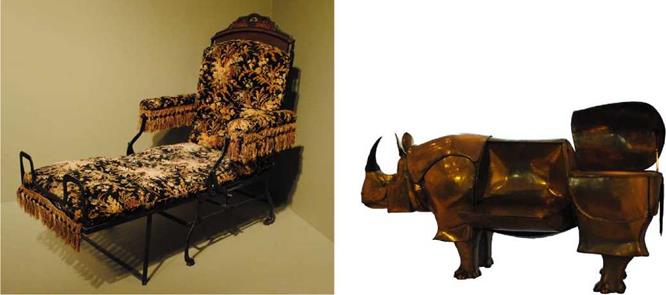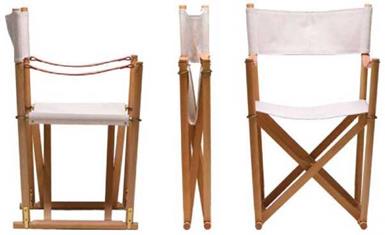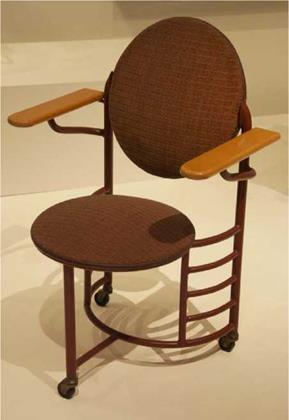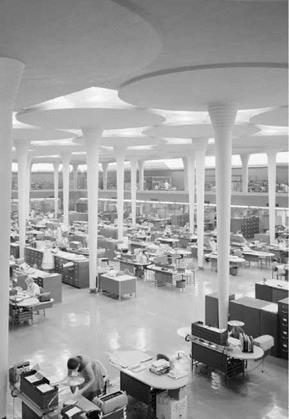 |
Mechanical joinery can allow furniture to transform into different shapes, as shown in the American drop-leaf table (Figure 3.45). The classic American colonial chair-table was an armed chair resembling a throne with a pivotal back that could easily convert to a table (Figure 3.46). This idea inspired Zabro, designed by Alessandro Mendini in 1984, and manufactured by Zanotta (Figure 3.47).
Figure 3.45 American drop-leaf table, 1815-1830. Courtesy of Cincinnati Art Museum. Centennial Gift of Mr. and Mrs. Carl Bimel, Jr., in memory of Mrs. Carl Bimel, Sr. Accession No. 1981.471.
 |
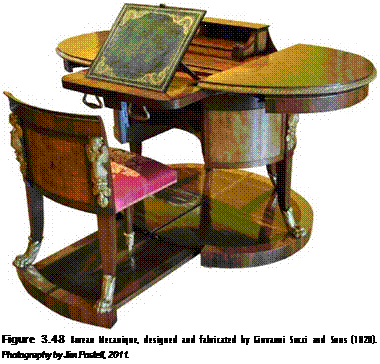 |
Giovanni Socci and Sons fabricated a transformable Empire-style mechanical study. The piece was fabricated in Florence, Italy, around 1820 (Figure 3.48). It transforms from a closed, well-defined oval bureau into an open study, composed of a three-legged chair and writing table using a complex closure mechanism. The drawing board and inkwell holders located in front drop down, and the two sides slide to form the closed oval bureau.
It was common during the mid-1800s for inventors, designers, and engineers to apply for patents for their adjustable or mechanical furniture. Cevedra B. Sheldon received a patent for his adjustable folding chair in 1876, which was in line with other patent furniture at the time, during which mechanical furnishings reached their height in the last quarter of the nineteenth century. The patented folding chair shown in Figure 3.49 was manufactured by the Marks Adjustable Folding Company from 1877 to 1897. It is mechanically adjustable by the use of a side lever located on the seat rail. The chair was used as a lounge chair; for those who were ill, recuperating, or needed assistance; as a smoking chair; and even as a bed. Made of iron, walnut, cane, and upholstered fabric, the chair was advertised as "the king of all chairs."
Remarkable for its craft and unique playful appeal is Frangois-Xavier Lalanne’s Secretaire Rhinoceros, completed in 1966. "Rhinocretaire" is a life-size metal rhinoceros whose side components open up to double as a desk (the name itself being a pun, combining the French word for "rhinoceros" with the word for "writing desk," secretaire). The polished brass secretaire, made with brass-plated sheet steel and leather has hinged doors that open and reveal seven interior storage compartments (Figure 3.50). It is a monumental sculptural effort of which three versions have been made (1964, 1975, and 1993).
|
Figure 3.50 Secretaire Rhinoceros designed and fabricated by Frangois – Xavier Lalanne (1966). Photography by Jim Postell, 2011.
Folding chairs, butterfly tables, extending draw tables, and transformable cribs can transform from one state to another. The classic aluminum folding chair, the wooden folding director’s chair, and Trefoldestolen (Figure 3.51) are examples of remarkably simple furnishings that physically transform for use, transport, and storage. The adjustable armchair 111 Wink, designed by Toshiyuki Kita in 1980 and produced by Cassina, utilizes an internal system of a welded steel armature; padded with Dacron fiberfill; covered in fabric, leather, or vinyl to transform its profile, which enables one to recline close to the floor or sit upright in a conventional manner (Figures 3.52 and 3.53).
|
|
|
|
|
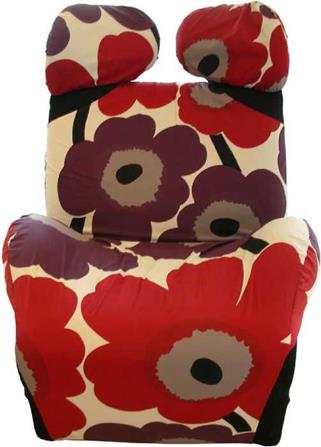
Movable
Movement can enhance the function of furniture. Alvar Aalto’s Tea Trolley serving cart (1936) was designed to roll about easily (Figure 3.54). The large wheels are painted wood and are banded with rubber to reduce the noise caused by movement. Frank Lloyd Wright’s office chairs produced for the S. C. Johnson Wax headquarters in Racine, Wisconsin (Figures 3.55, 3.56, and 3.57), utilize casters to promote functional movement. The casters and bronze feet are interchangeable. The chairs were specifically designed to freely roll about in space at a time when many chairs of the same typology did not.
|
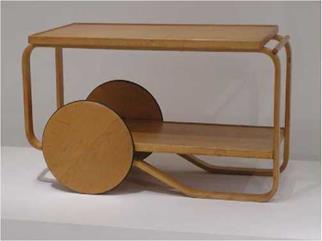
|
|
|
|
|
|
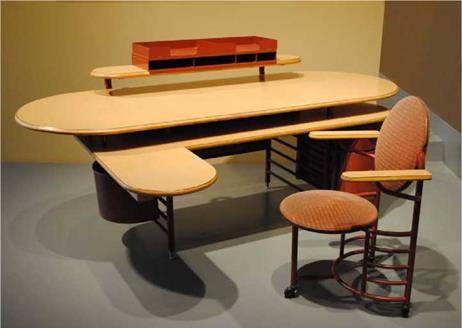
Summary
The first three chapters of this book have introduced concepts within furniture design, described aspects of function and social use, and have outlined characteristics of form, spatial organization, and typological orders related to furniture design.
Analyzing classifications of use and characteristics of form directs one’s thinking about furniture in terms of synthetic and semantic components. This process is helpful to introduce a foundation of knowledge that can be synthesized into a more holistic understanding.
The furniture studies that follow in Chapter 4 build upon the ideas presented thus far. The background, tectonics, and ideas in the selected pieces are presented in a more comprehensive and integrated manner and underscore the importance of context, time, and place in furniture design.
endnotes
1. Edward T Hall, The Hidden Dimension (Anchor Books, 1969). Hall coined the terms sociofugal and sociopetal in this book.
2. Ibid.
3. Kerry Capell, "How the Swedish Retailer Became a Global Cult Brand," Business Week, November 14, 2005, p. 96.
chapter

